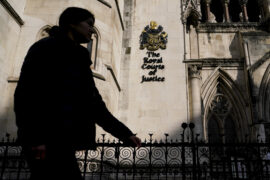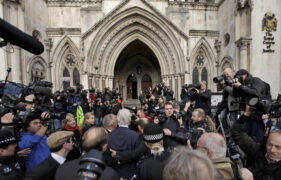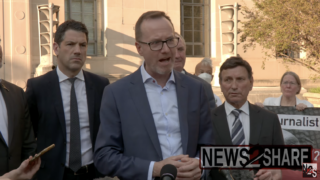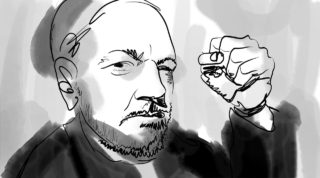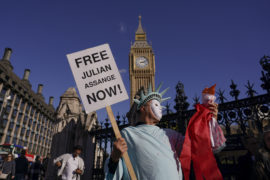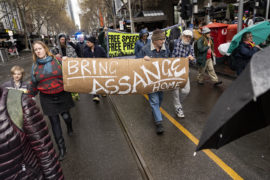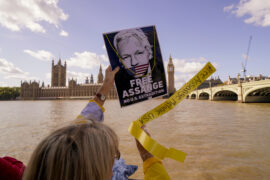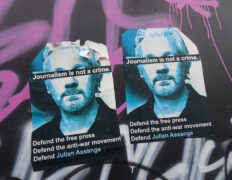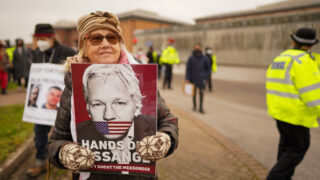 Illustration by Mr. Fish / Truthdig
Dig
Illustration by Mr. Fish / Truthdig
Dig
The Persecution of Julian Assange
This Dig series investigates the decade-long intimidation and repression campaigns led by the U.S. and British governments against imprisoned WikiLeaks founder Julian Assange, as well as global efforts by activists and media organizations to recognize his contributions to journalism and protect whistleblowers, in the name of First Amendment rights. A Dig curated by Truthdig staffWhat’s Next for Julian Assange
The WikiLeaks founder will get a chance to appeal extradition if assurances aren't made.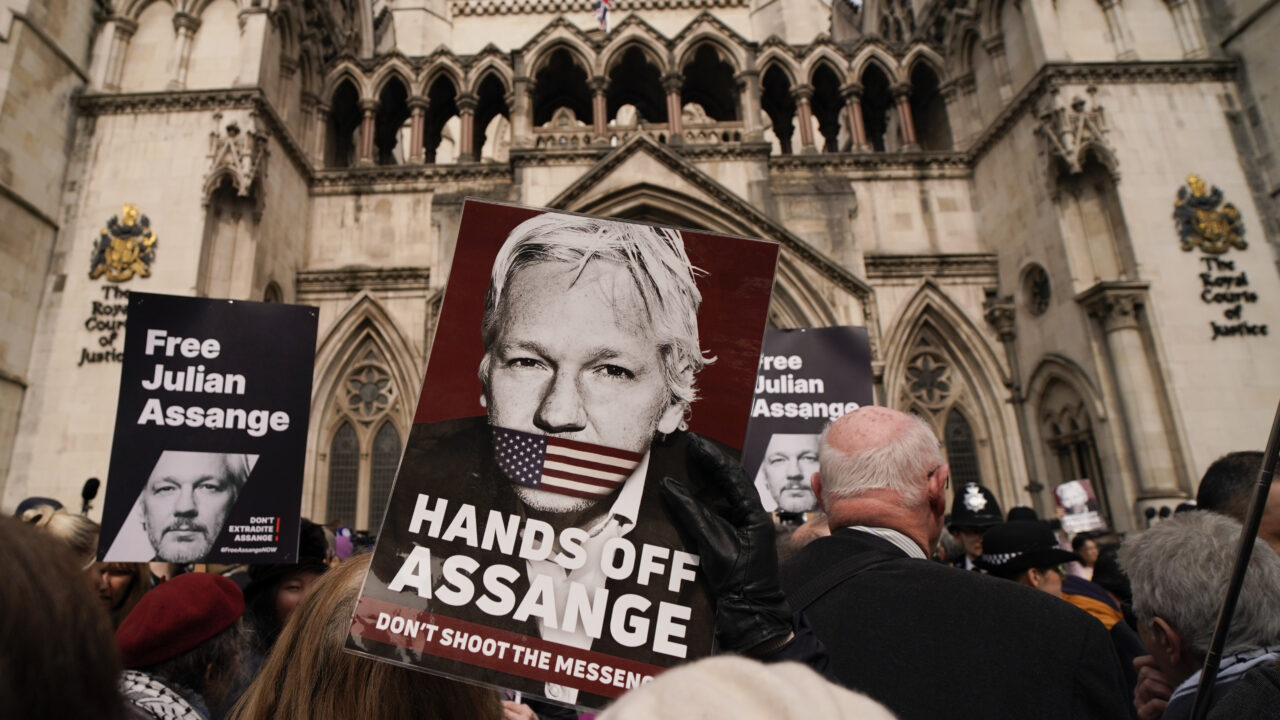 Demonstrators hold placards after Stella Assange, wife of Wikileaks founder Julian Assange, released a statement outside the Royal Courts of Justice, in London, Tuesday, March 26, 2024. Two High Court judges said they would grant Assange a new appeal unless U.S. authorities give further assurances about what will happen to him. The case has been adjourned until May 20. (AP Photo/Alberto Pezzali)
Demonstrators hold placards after Stella Assange, wife of Wikileaks founder Julian Assange, released a statement outside the Royal Courts of Justice, in London, Tuesday, March 26, 2024. Two High Court judges said they would grant Assange a new appeal unless U.S. authorities give further assurances about what will happen to him. The case has been adjourned until May 20. (AP Photo/Alberto Pezzali)
The hearings on Julian Assange’s appeal request ended yesterday, as expected, without closure. “We will reserve our decision,” said one of the two presiding judges. The choice to delay an announcement may have been influenced by the presence of several hundred Assange supporters gathered at the heavily policed entrance of the neo-Gothic Royal Courts building in Westminster.
A cold drizzle had thinned the previous day’s crowd of a thousand or more, but not by much. The lawyers arguing the U.S. government’s extradition request had to exit the court under escort through the chants and jeers, eyes straight ahead, pretending not to see the placards with Assange’s face next to sentences like JOURNALISM VS. WAR CRIMES: DON’T LET THE WAR CRIMES WIN and R.I.P. BRITISH JUSTICE: 1215 — 2012.
Dig deeper Nov 28, 2022Journalists Push Biden to Free Julian Assange
Five leading news organizations call on Biden’s Justice Department to end Trump’s persecution of Julian Assange.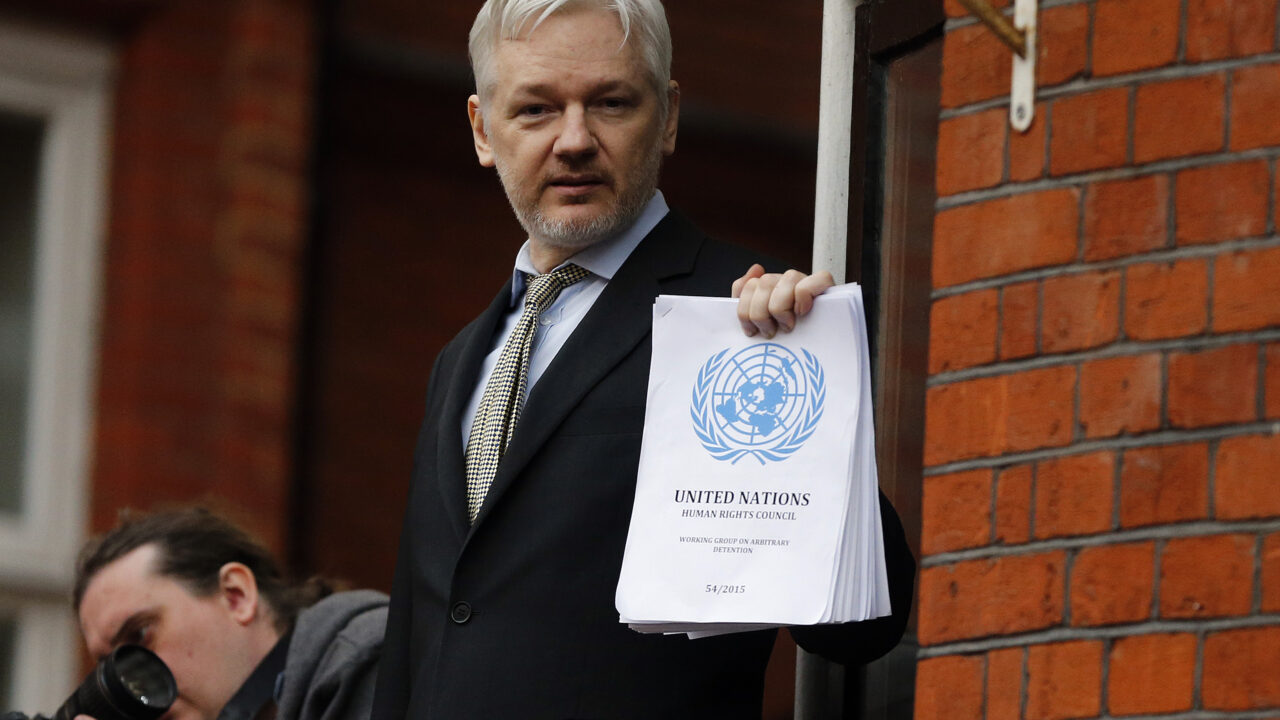 WikiLeaks founder Julian Assange stands on the balcony of the Ecuadorean Embassy to addresses waiting supporters and media in London, Friday, Feb. 5, 2016 (AP Photo/Frank Augstein)
WikiLeaks founder Julian Assange stands on the balcony of the Ecuadorean Embassy to addresses waiting supporters and media in London, Friday, Feb. 5, 2016 (AP Photo/Frank Augstein)
On November 28, the editors and publishers of five international media outlets released a joint letter— under the title “Publishing is Not a Crime”—calling on the U.S. government to end its prosecution of Wikileaks founder Julian Assange. The date was significant. Twelve years prior, on November 28, 2010,the same five newspapers—The New York Times, The Guardian, Le Monde, El Pais and DER SPIEGEL—each published revelations in cooperation with Wikileaks that made headlines around the globe.
“Cable gate,” a set of 251,000 confidential cables from the U.S. State Department disclosed corruption, diplomatic scandals and spy affairs on an international scale. According to The New York Times, the documents told “the unvarnished story of how the government makes its biggest decisions, the decisions that cost the country most heavily in lives and money.”
Dig deeper May 6, 2013The Death of Truth
The use of vast global resources against Julian Assange and WikiLeaks presages a dystopian world where anyone who exposes corruption, lies and crimes of power will be branded a terrorist.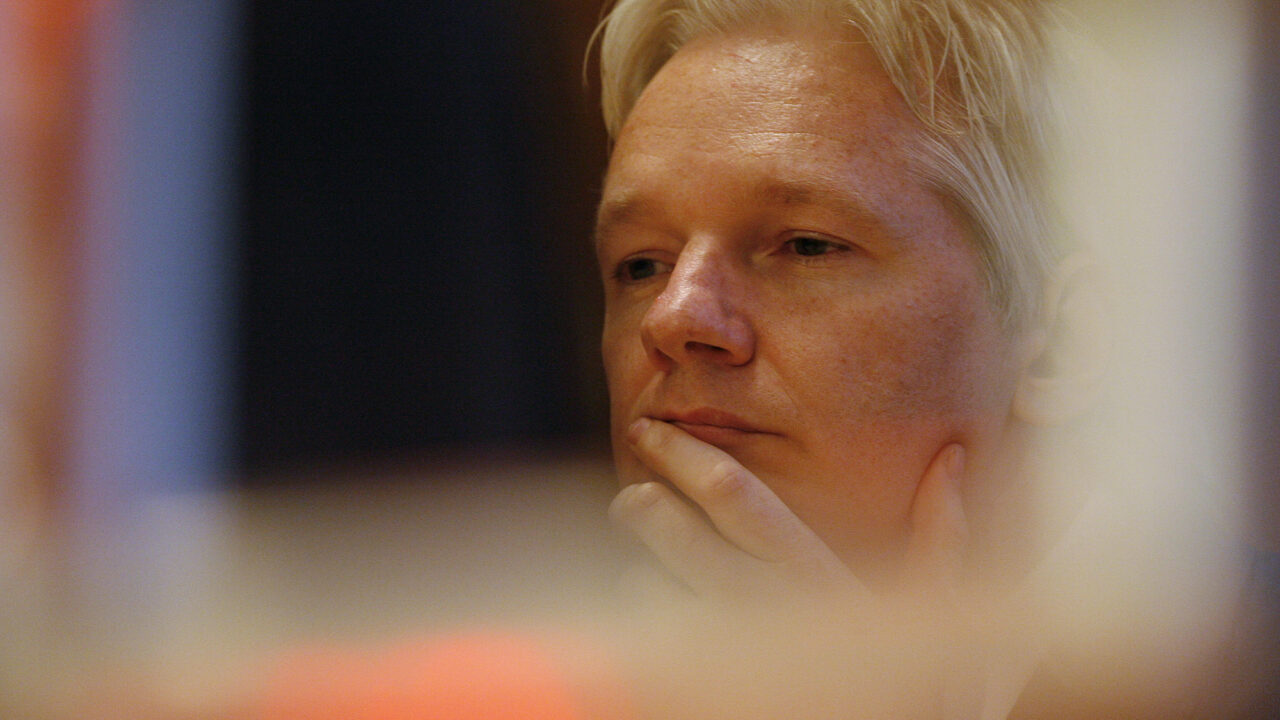 WikiLeaks founder Julian Assange reacts during a public debate chaired by Jason Cowley, editor of the New Statesman, and hosted by the New Statesman and the Frontline Club at Kensington Town Hall in London, Saturday, April 9, 2011. (AP Photo/Akira Suemori)
WikiLeaks founder Julian Assange reacts during a public debate chaired by Jason Cowley, editor of the New Statesman, and hosted by the New Statesman and the Frontline Club at Kensington Town Hall in London, Saturday, April 9, 2011. (AP Photo/Akira Suemori)
LONDON — A tiny tip of the vast subterranean network of governmental and intelligence agencies from around the world dedicated to destroying WikiLeaks and arresting its founder, Julian Assange, appears outside the red-brick building on Hans Crescent Street that houses the Ecuadorean Embassy. Assange, the world’s best-known political refugee, has been in the embassy since he was offered sanctuary there last June. British police in black Kevlar vests are perched night and day on the steps leading up to the building, and others wait in the lobby directly in front of the embassy door. An officer stands on the corner of a side street facing the iconic department store Harrods, half a block away on Brompton Road. Another officer peers out the window of a neighboring building a few feet from Assange’s bedroom at the back of the embassy. Police sit round-the-clock in a communications van topped with an array of antennas that presumably captures all electronic forms of communication from Assange’s ground-floor suite.
The Metropolitan Police Service (MPS), or Scotland Yard, said the estimated cost of surrounding the Ecuadorean Embassy from June 19, 2012, when Assange entered the building, until Jan. 31, 2013, is the equivalent of $4.5 million. Dig deeper


